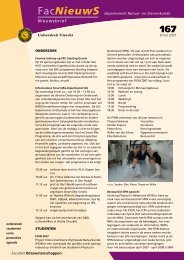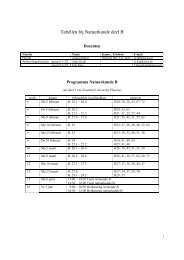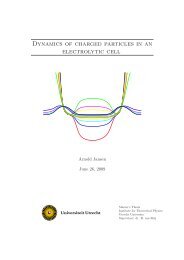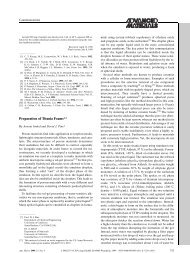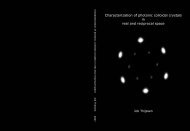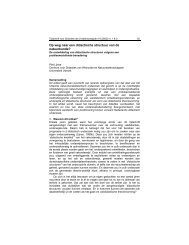4.6.1 The influence <strong>of</strong> the diameterThe volume <strong>of</strong> the colloids plays no part in the theory <strong>of</strong> section 4.2. Changingthe diameter σ i will therefore not lead to different solutions for the densitypr<strong>of</strong>iles and potential. The origin <strong>of</strong> the independency <strong>of</strong> size lies in the densityregion for which the theory applies. Since the density is low, the colloidsare considered an ideal gas, interacting as point particles, although having aspecific size σ. As already shown in figures 4.4 and 4.6, this approximationis not that bad, when comparing to simulations that do include size. Althoughthe density pr<strong>of</strong>iles ρ i (x) and the potential φ(x) do not change, thedimensionless packing fraction η can have spectacular solutions, though. Intheory, every colloidal family with charge number Z, gravitational length Land diameter σ, can be positioned at a desirable height, by adding ’invisible’small components <strong>of</strong> other colloids. Also the dimensionless density distributioncan be adjusted as well, by adding the right components. This maysound remarkable, but it is nothing more than a magic trick. The diameter<strong>of</strong> the particles is just a scaling factor for the density pr<strong>of</strong>iles. By choosing avery low diameter for some components it looks like if the others ’float’ in thesuspension. An example, figure 4.11, shows the deceitful packing fraction.0.02110.80.012E x(mV/cm)0.60.40.2η i0 20 40 60 80 100304x (cm)500 20 40 60 80 100x (cm)Figure 4.11: An example <strong>of</strong> a 10 component system. Components 1 - 5 havea particle radius σ big = 1500nm. Components 6 - 10 cannot be seen, becausetheir radius σ small is too small: σ small ≪ 0.01σ big . The number density isidentical to the number density <strong>of</strong> figure 4.9. The packing fraction though,looks spectacular. The diameter <strong>of</strong> the particles is just a scaling factor <strong>of</strong> thepacking fractions in our theory.It remains a question for experimentalists how big they can make their particlediameters in order to get results like figure 4.11. For our theoreticalobservations though, this factor does not play a role until we are going to30
observe higher densities, where excluded volume becomes important.4.6.2 The influence <strong>of</strong> the saltIn all sections the salt concentration is chosen to be either ρ s = 3µM, orρ s =< 0.1nM. The first value is a very convenient concentration to showinteresting phenomena like the ’colloidal Brazil nut effect’ (4.3), the layering<strong>of</strong> components, linear pr<strong>of</strong>iles and many other phenomena discussed s<strong>of</strong>ar. The latter concentration(s), ρ s < 0.1nM, shows the effects somewhatstronger, but cannot easily be realised in experiments since e.g. water alreadyhas a minimum concentration <strong>of</strong> 0.1µM <strong>of</strong> ions. It is chosen however,to imitate a system <strong>of</strong> colloids in the presence <strong>of</strong> counter-ions only, as <strong>of</strong>tenused in simulations or in anorganic solvents.Two examples will show an effect we already knew from theory. By increasedsalt concentrations the density distributions collapse, while the electric fielddisappears, see figure 4.12. As well, the segregation disappears, as shownfor a binary system in figure 4.13. While decreasing the salt concentrationthe mean heights <strong>of</strong> the components tend to a constant. This constant isdetermined by the system height H. The mean hight <strong>of</strong> component i in thehigh salt limit is equal to the gravitational length h i = L i , as it should be(equal to a barometric distribution). The region where ρ s < 1 2 Z2 ρ, wherenon-barometric pr<strong>of</strong>iles are expected, is below ρ s < 3 · 10mM.4.6.3 The layer widthThis section is a consideration <strong>of</strong> the layer width <strong>of</strong> the pr<strong>of</strong>iles, i.e. thelength or height over which the colloids <strong>of</strong> a certain species extend. It will bedenoted by ξ i . Most arguments will be qualitative, since an exact knowledge<strong>of</strong> ξ i requires analytical solutions for the density pr<strong>of</strong>iles or, equivalently, thepotential. Most attention will be paid to the so-called linear regimes, i.e.where Z −1 ≪ y ≪ 1, with y = Zρ/2ρ s (see equations (3.7)).The width <strong>of</strong> the regime where the density pr<strong>of</strong>iles decay linearly decreaseswith the number <strong>of</strong> components, as could already be seen by comparingmonodisperse with binary suspensions. If one proceeds to add components,these linear regimes disappear at a certain point, due to entropy. The number<strong>of</strong> components that can be added until the linear pr<strong>of</strong>iles break down, dependson the height <strong>of</strong> the suspension and the mass per charge <strong>of</strong> the components.This loose argument cannot be made rigorous, though from a physical point <strong>of</strong>view this can still be understood: as explained, layering occurs at sufficientlow salt concentrations. As an effect <strong>of</strong> the layering, the lower colloidalcomponents are compressed by the weight <strong>of</strong> the higher components (see31
- Page 1: Sedimentation Equilibrium of Mixtur
- Page 4 and 5: 5 Charge Regulation in the Low Dens
- Page 6 and 7: programming?Do I like programming?T
- Page 8 and 9: Additional information, often writt
- Page 10 and 11: 1.2 Sedimentation equilibrium of mi
- Page 12 and 13: make them spark. . . Wait, wait! I
- Page 14: dG = −SdT − V dP + ∑ αµ α
- Page 17: with ν λ = ν 0 +λw, the free en
- Page 20 and 21: eservoir is:µ res± = k B T ln(ρ
- Page 22 and 23: x-axis, only τ xx = −(ɛ/8π)E 2
- Page 24 and 25: is denoted by ρ i . The salt ions
- Page 26 and 27: numbers for the parameters Z i , L
- Page 28 and 29: 2Case (a)4.5Case (a)ρ +E (mV/cm)1.
- Page 30 and 31: is plotted as a function of Z 2 /Z
- Page 32 and 33: 0.1i=320a0.080.06η i0 5 10 15 20ρ
- Page 34 and 35: Z 16=2993a0.6210 3 η iZ 11=2500.40
- Page 36 and 37: 0.02210.83E x(mV/cm)0.60.40.0140.25
- Page 40 and 41: 0.01ρ s=10 −3 Mρ s=10 −5 Mρ
- Page 42 and 43: 0.03108642η i 0.01500 5 10 150.031
- Page 44 and 45: The next constant that can be solve
- Page 46 and 47: 4.6.5 Donnan-method for polydispers
- Page 48 and 49: and try to fill the holes, or try t
- Page 51 and 52: Chapter 5Charge Regulation in the L
- Page 53 and 54: 5.1.2 Numerical resultsThe example
- Page 55: Discussion The mean height of the s
- Page 58 and 59: Z i (x) that converges, at least in
- Page 60 and 61: Other extensions are planned to inc
- Page 62 and 63: their buoyant mass. The force that
- Page 64 and 65: (π/6)ρ i (x)σi3 the local packin
- Page 66 and 67: 0.010.008ρ +0.006 i=10.5hη i/σi
- Page 68 and 69: species, and (B) L i = 2 × (250/Z
- Page 70 and 71: A.7 AcknowledgementsIt is a pleasur
- Page 72 and 73: length by Peter Debye. In dense col
- Page 74 and 75: One quick check shows ∫ ∞dx Q(x
- Page 77 and 78: Appendix CThe block modelThe model
- Page 79: Index of frequently usedsymbols and
- Page 83 and 84: Bibliography[1] J. Perrin, (1913),



